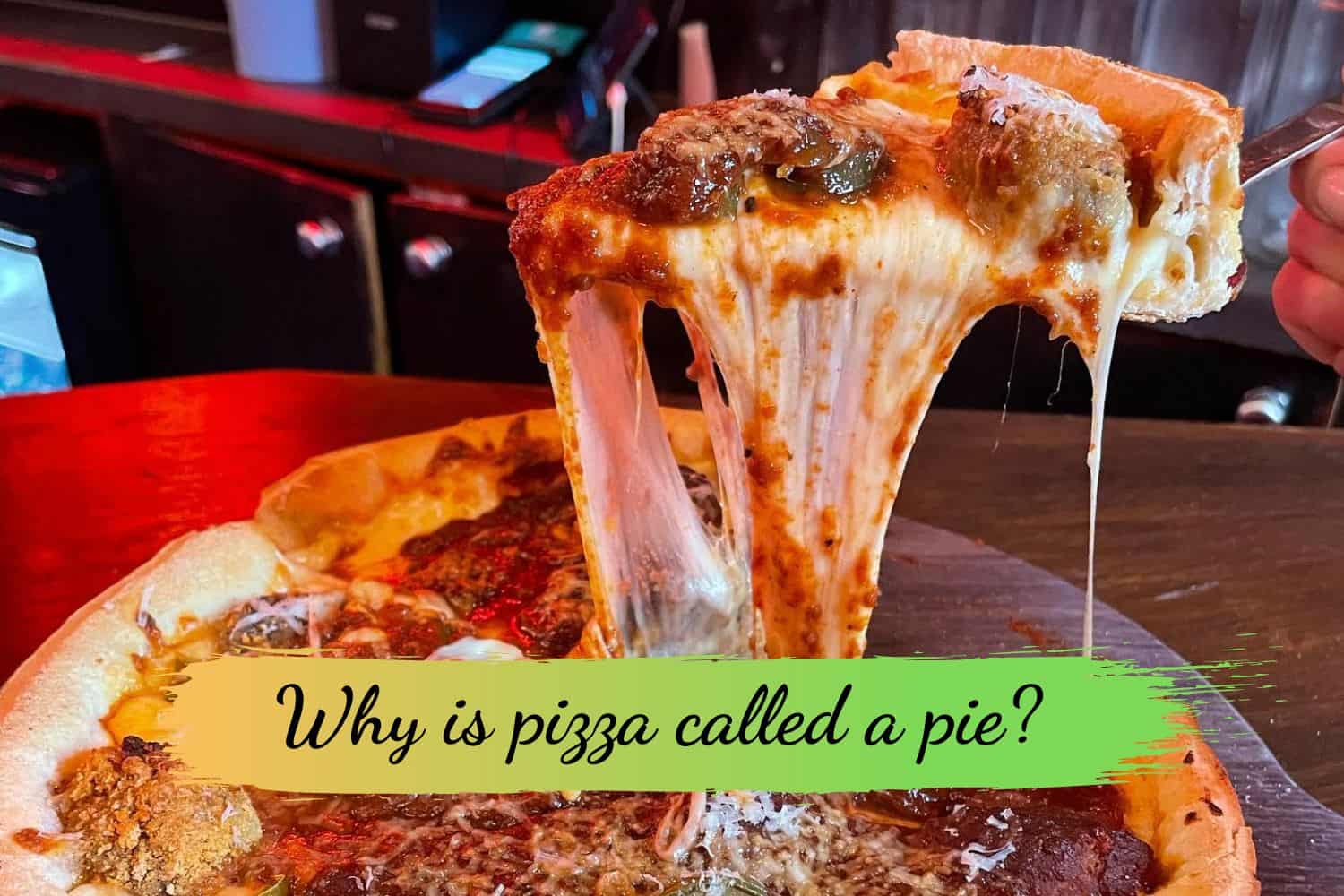Why is pizza called a pie?

Have you ever stopped to wonder why is pizza called a pie? There are several different theories on the origin of this phrase, but none have been conclusively proven.
Italian Americans popularized pizza, a dish reminiscent of the pie because of its crust, triangle slices, and circular shape. Originally called “tomato pie” in English, the language eventually merged with Italian to create “pizza”.
In today’s blog post, we’ll explore some of these possible explanations and review some fun facts about the beloved Italian-American classic. From its chewy crust and a signature blend of cheese to its countless topping variations, pizza has become an international phenomenon – and calling it a pie is just one aspect that makes this dish unique. So if you’ve ever wondered why people refer to their slice as “pie” – keep reading!
What Is A Pie?
Discover the Definition of a Pie: Understanding the unique qualities of this savory meal enables you to differentiate it from other dishes. A pie is a delicious creation where a pastry is placed in a shallow container, filled with savory ingredients, and baked until the crust is crispy. Traditional pies include a second crust on top and are typically 8 inches in diameter and 2 inches thick. You’ll find common fillings like custard, sweet fruit, or pastry cream. Made with flour, water, salt, shortening, or butter, pies are exclusively baked, meaning fried, boiled, or steamed varieties are exempt.
When it comes to pie, the pastry is the foundation – and it must come from grain, wheat, rice, cookie crumbs, or cracker to qualify as a true pie. In Europe, a pie has both a bottom and top crust, while in America, the bottom crust is the star of the show. But regardless of location, the pastry must be sturdy enough to support the filling within.
From classic apple pie to creamy chocolate pie, there are plenty of variations to choose from. However, the American obsession with apple pie is unmatched, while pumpkin pie is a quintessential addition to any Thanksgiving meal.
If you prefer a more exposed dessert, you may want to opt for a tart instead. Tarts have a thicker base that showcases the filling from above, while pies are closed with a thinner crust. Whatever your preference, keep the golden rule of pies – the grain-based pastry is crucial – in mind when baking your own.
What Is A Pizza?
Pizza may be a staple dish for many, but are you aware of its intriguing origins and limitless possibilities? Essentially, pizza is a savory, circular flatbread made from a flavorful blend of wheat flour, yeast, warm water, and a sauce made using luscious tomatoes. The dough is then expertly seasoned with an assortment of mouth-watering toppings, dominated by mozzarella cheese, and baked to perfection in an oven.
The outcome? An irresistible dish with a crispy textured crust and a heavenly, melted cheese center, that can make or break your pizza indulgence experience! Fancy a meaty medley? Top your pie with an array of flavorful meats like juicy sausage, spicy pepperoni, tender bacon, and succulent poultry like chicken. Crave vegetarian? You can tailor your pizza with a range of delicious toppings, like crispy mushrooms, earthy oregano, briny olives, crunchy broccoli, tangy artichokes, fresh green pepper, or nutrient-rich spinach.
Experience the pleasure of pizza today and explore the endless flavor combinations that will make your taste buds tingle.
Discover the wide-ranging world of pizza varieties from around the globe. With each place having its unique fillings and recipes, it’s challenging to determine which is the “best” pizza. However, one thing remains consistent – the easily edible crust.
Among the most popular types of pizza are St. Louis, California, Greek, Sicilian, New York-Style, Chicago, and Neapolitan. Neapolitan pizza, with its origins in Italy dating back to the 18th century, is considered one of the oldest. Created as a meal for seaside communities, it was primarily enjoyed by the less affluent.
Today, the Neapolitan pizza has many variations, including Margherita and Marinara pizzas, which remain staples in Italian cuisine. Indulge in the timeless appeal of Neapolitan pizza and celebrate its rich history.
When it comes to pizza, the term “pie” or “pizza pie” refers to the entire pizza, not a specific type of pizza. This term is often used in New York, where pizza is considered a noun with an unspecified quantity, like water. Ordering a “slice” or a “pie” of pizza is common, while “piece of pizza” or “pizza” alone may not make sense in that context.
In New York, the term “pizza” is vague and ambiguous, similar to “water.” One would not simply order “water,” but rather a specific type of water such as a “bottle of water.” Similarly, when ordering pizza, the term “pie” or “slice” is used to clarify the order. This translates to a specific quantity, either a “pie of pizza” or a “slice of pizza.” Using the terms “a pizza” or “piece of pizza” is nonsensical in this context.
Whether you’re ordering a whole pizza or just a slice, understanding the lingo can prevent confusion. For example, “I bought two whole pizza pies last week, but only a slice today.” To describe a pizza, you might say, “I cooked a beautiful 14″ pie in my oven last night.” Keep these nuances in mind and enjoy your slice (or pie) of pizza to the fullest!
Why is pizza called a pie?
Discover how pizza got its unusual name “pie”, originating from the late 1800s when Italian immigrants brought the dish to the United States. Thanks to the pie-like qualities of the crust, triangular slices, and circular shape, Italian Americans popularized tomato pies, which later adopted the name “pizza pie” as the English and Italian languages merged.
Familiar with the catchy phrase “pizza pie”? It was popularized by Dean Martin in his 1953 hit “Amore”, and it’s still captivating our hearts and taste buds today!
Conclusion
From ancient Greece to the modern day, pizza has come a long way in its evolution. The name “pizza” actually originates from the Latin “pinsa,” meaning “flatbread.” However, regardless of the derogatory connotation attributed to it, pizza is still called pie. This may be because the doughy flatbread and topping combination resemble an open-faced American-style fruit pie.
So, although the origins are debatable, it’s clear pizza earned its nickname as ‘pie’ eons ago and has since become a staple of convenience, culture, and cuisine around the world. There is no doubt when one mentions “pie,” they will soon think of that cheesy, gooey slice of joy: pizza!
If you want to know more information, visit our website here.
References:
Grow Your Own Slice of Pizza Pie! Recommended Plants
3 Ways to Make Pizza – wikiHow
I’m Vance Douglas, and I love making pizza. In fact, I love it so much that I decided to build my own oven to make it in. It’s a brick oven that I made myself, and it’s the best pizza oven you’ll ever find.
Making pizza is a passion of mine, and I’m always looking for new ways to make it even better. I’ve been making pizza for years, and I continue to learn more about the art every day. My goal is to create the perfect pizza, and I’m getting closer and closer every time.




